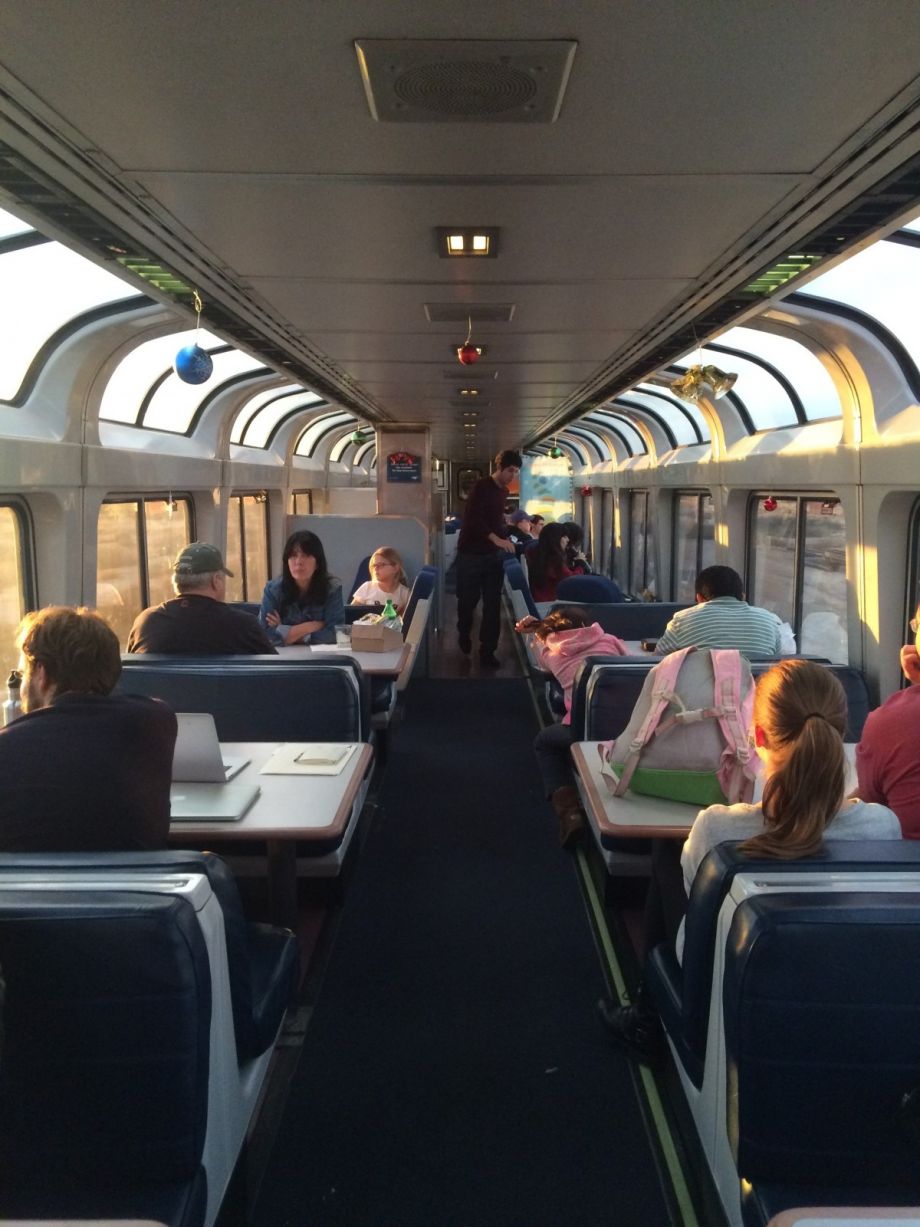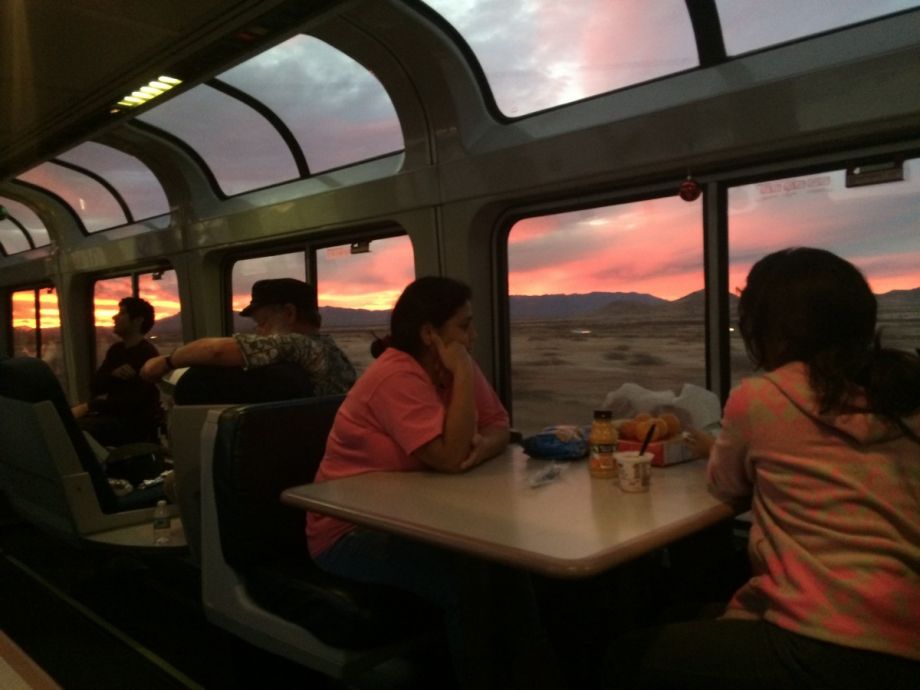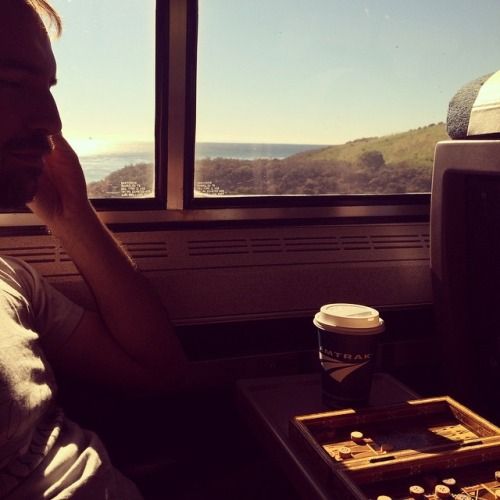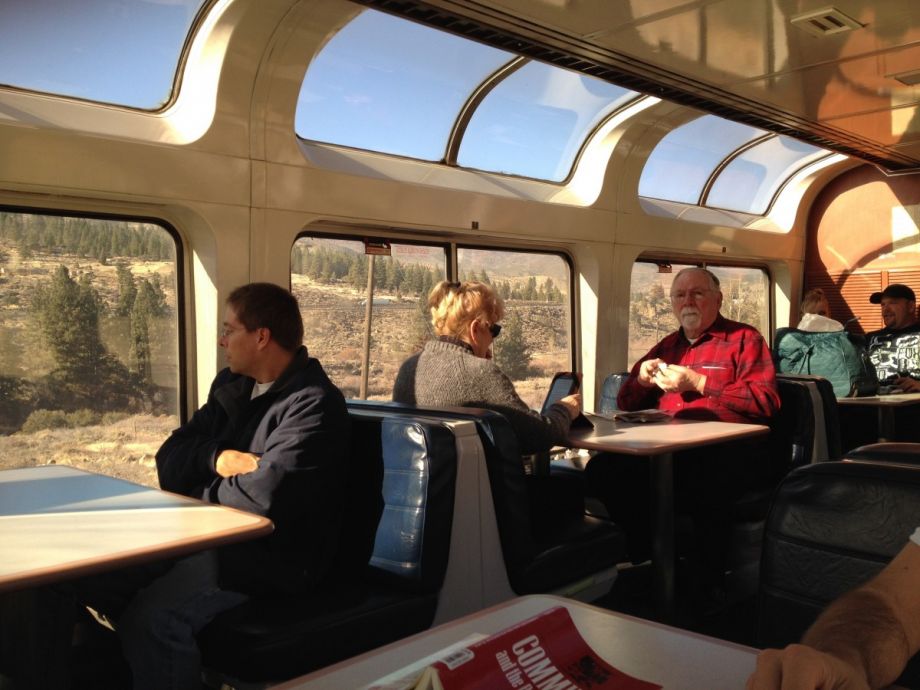“What people don’t like about the train is the time lapse. People don’t have time to tie their own shoes these days.” Trent, a fellow passenger on Amtrak’s Sunset Limited from New Orleans to Los Angeles, was philosophizing about the train. Trent is a middle-aged African-American man from California with whom I struck up a conversation in the observation car, which, for those of you who aren’t versed in the lingo of the rails, is the living room of a long-distance train, heavily windowed and designed for friendly interaction. Rolling through the desert, Trent and I talked for more two hours about family, spirituality, and all the other things that come up when you have opted to ride across the country with strangers and without WiFi.
“People [usually] just want to get from point A to point B as quickly as possible. We don’t give ourselves the chance to be in the moment,” Trent says. “Whether it’s good or bad, you grow. It’s about experiences.” He was describing something special about the long-distance train: It is a place to slow down and experience the present.
The long-distance train is one of America’s greatest and least heralded public spaces. Perhaps without intending to, the train encapsulates many qualities of public spaces that planners and designers try so hard to create. It is democratic in that it serves people across many different communities, geographies and interest groups. It is diverse in that it appeals to a broad spectrum of people across ages, ethnicities, races, nationalities and genders, and critically, it facilitates connections between these different people. (While traveling from New Orleans to Los Angeles, I met a gay couple going to Houston, a Latino family headed to Albuquerque, an indie rock-loving pizza-maker from Austin, a minister going to Tucson and an L.A.-bound retired merchant marine who taught me how to play dominoes.) Unlike planes, trains foster a sense of appreciation and curiosity about the landscapes through which they pass, which in turn help passengers develop a deeper connection to place.
I became interested in studying long-distance train rides after my partner and I took the California Zephyr, one of Amtrak’s most majestic routes, from Chicago to San Francisco last year. Running through the gorgeous scenery of the Sierras and the Rockies, we had time to reflect, be creative and meet strangers.
Michel Foucault coined the term “heterotopia” to describe what he called “placeless places,” autonomous zones where societal rules are reinterpreted — like the train. As a planner and cultural programmer, I became fascinated by how the train affords these kinds of experiences. I wondered: What qualities of the train facilitate these meaningful moments? What can planners, designers and others learn from it that might apply to other public spaces and to cities in general? These questions are the basis for my master’s thesis in the Department of Urban Studies & Planning at MIT (more on my blog here). Thanks to a travel grant and a discounted rail pass program that Amtrak offers, I took a 30-day train ride around the country to study whether there was indeed something special happening on these long-distance rides, and whether there was anything the design and management of the train could teach urban planners and cultural programmers about public space.
My study points to aspects of long-distance train travel that may help to define what it means to be a great public space. For starters, good public spaces (busy parks, main streets, plazas) attract a diverse cross-section of a community or city and at best, can facilitate interaction across perceived differences. The train exemplifies this by providing circumstances for much more intensive interactions among strangers than usually happen in cities. For example, while our train climbed the mountains of Montana, I began talking with an Irish-American heavy machine operator from rural Oregon who was heading to work in the oil boom towns of North Dakota. In other circumstances we might have disregarded each other, thinking we had nothing in common. But listening to him tell me about his children, and he listening to me talk about my parents’ divorce, helped us find empathy for each other and learn new things about the world through that empathy.
The physical qualities that help to facilitate this sense of connection are human-scale design, a clean and safe environment, and an aesthetic that is straightforward and not overly fanciful. The dimensions of the car make it (generally speaking) cozy and comfortable, but spacious enough that you aren’t on top of the person seated next to you. (When people are too physically close they tend to retreat emotionally and mentally, as anyone who has ever ridden the 1 train during rush hour in Manhattan can attest.)
That long-distance trains aren’t designed with one specific aesthetic, demographic or psychographic in mind means that the ride is more about what’s unfolding within the space rather than the materiality of the car. It also frames the passing landscape in a way that makes it easy to use as a conversation starter. This follows the concept of “triangulation,” which William H. Whyte, a famous public space researcher and advocate, coined to describe a third element that gives people something easy to talk about.

Dining cars are one of several spaces where passengers can choose to interact on the train. (Photo by Danya Sherman)
Another important element encouraging interaction is what I will call the “together alone” factor. Riders are in the same space — and apart from everything and everyone else — for an extended period of time. Being in a shared physical space that’s also outside of one’s normal environment for an extended duration facilitates a special sense of focus and an enhanced sense of accountability, which can lead to conversations we wouldn’t normally have with strangers. (Online, the standard for conversation is a different ball game but we aren’t talking about that here.) Democratic theorists since the Ancient Greeks have celebrated public discourse. But where in contemporary offline America does this occur? Housing policies have segregated us by race, class and political leanings. It is increasingly difficult to have open, face-to-face conversations about important topics. Yet on train rides I observed conversations between total strangers about race, religion, sexuality and other taboo topics. Unlike the flame wars of the Internet, these conversations were civil.
The balance among autonomy, choice and limitations is perhaps another condition for creating positive experiences in public spaces. Most long-distance routes have several different cars designed to provide different experiences — group tables, chairs for looking out the window, a cafe with food and drink, a diner car, etc. Given the chance, I would add a few kinds of experiences to this list — how about a playroom for kids or a dance party car? — while keeping the same balance. In all of these spaces, passengers have some freedom to move around, but not so much as to make it overwhelming or stressful.
But if a long-distance train is a great public space, it is one that not enough Americans experience. Although Amtrak ridership is on the rise (there were a record 31.2 million passengers in FY 2012), that number still only encompasses 10 percent of the American population. No wonder Amtrak always has to justify itself to Congress.
There are other ways we could make train travel more democratic and diverse, including lowering prices and offering new amenities like food and programming that reflect the cultural diversity of the nation. Another huge help would be a more robust rail network, the political implications of which are explored in the Van Alen Institute’s Life at the Speed of Rail. America is becoming more and more demographically complex, and we need our public spaces to proactively consider everybody, especially those communities and individuals most marginalized by infrastructure funding, mobility patterns and institutions. The train also offers a rich platform to learn about patterns of inclusion, exclusion, power and resistance. The railroad figures strongly in so many key American movements: the Great Migration, civil rights and desegregation, westward imperialism, and so many more.
Beyond serving as a place for connection, education and engagement, the train provides another important benefit of public space: room to think. Watching the landscape pass by while in between stations provides many people with important creative and meditative fuel. As Jess and Joseph, an artist and a writer I met on the train from Boston to Chicago, put it, “We can express ourselves on the train.” This quality is the inspiration behind the writer’s residency, a program that Amtrak recently began. Cities can learn from that — space for individual creativity and expression, after all, could be better incorporated into the design and management of our public spaces and cities more generally.
Indeed, 30 days on a train taught me lessons that can be applied on an individual, local and national scale. First on the list is the fact that as individuals we need to make the decision to “take the train” more frequently — give ourselves time to be in the moment and connect with the people around us and the places we inhabit. On a local level, we can learn from how trains run about how to design spaces that serve a diverse spectrum of people. Nationally, we can capitalize on the qualities that are unique to the train by improving the rail network and mining the possibilities to make what is a great public space (not to mention a more efficient and equitable transit system) even better. I learned to see America for the first time. What could you learn?
The column, In Public, is made possible with the support of the John S. and James L. Knight Foundation.

Danya Sherman is an urban & cultural planner who specializes in collaboratively developing strategy, research, and programs that work towards a more creative and just society. She is currently a Research Consultant to ArtPlace America, the Center for Performance and Civic Practice, a contributing writer for Next City, and the Case Study Initiative Project Manager at the MIT Sam Tak Lee Real Estate Entrepreneurship Lab. Previously she founded and directed the Department of Public Programs & Community Engagement at Friends of High Line. She holds a Master's in City Planning from MIT and a Bachelor of Arts from Wesleyan University.











